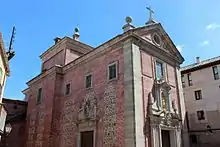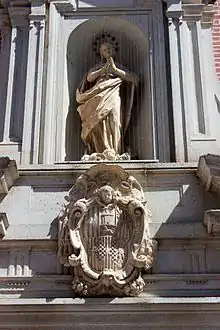Convento de la Purísima Concepción, Toledo
The Convento de la Purísima Concepción, also called Convento de Capuchinas, is a convent located in the city of Toledo, in Castile-La Mancha, Spain.


The buildings are late 17th century although the institution developed from an earlier Augustinian community.[1] The chapel was completed by 1671, date in which it was consecrated; and in 1677, year of the death of the convent's patron Cardinal Don Pascual de Aragón, the works of the conventual dependences were practically finished.
Description of church
Although the church's crossing, in its lateral development, protrudes slightly in floor, the plan cannot be described as a Latin cross, it is essentially rectangular with a single nave divided in three sections: the crossing, the greater chapel and the choir, high, at the feet, on a wide lowered arch. The nave and the main chapel have half-barrel vaulted ceilings and lunettes; In the transept, dome on pechinas (pendentives), without drum and with blind lantern. On a base of ashlar masonry, there is a limpid and undeveloped interior elevation, articulated by Tuscan pilasters that, extended on the smooth frieze, reach the capitals located directly under the cornices. Four buttresses support the dome in the crossing. Regarding this, the presbytery is slightly elevated, where the pilasters of articulation appear subtly boxed; On its front, the main altarpiece; On the side of the epistle, the fence that gives to the low choir of the nuns - wide rectangular stay and of low height, whose low ceiling is materially occupied by an enormous shield, frescoed by Francisco Rizi, of the Cardinal Pascual de Aragón, and on the gospel side, the chapel of the Christ.
Fine simplicity and marked desornamentation are the criteria handled throughout the interior. The counterpart is in the nobility of materials - marble, jaspers and bronzes - used for altarpieces, picture frames and plaques with inscriptions.
Each of the details that configure this architectural space is executed with a weighting, exquisiteness and a final finish that surprise; Fruit, all of it, of a measured proportion and balance.
The exterior is, in general, of brick seen with rafters of stone, of cubic volumes and rectilinear profiles, as is customary in the 17th-century architecture of Toledo.
Other buildings
Among the conventual dependences is to note the small cloister, which acts as a distributing element of rooms, formed by two floors, four galleries each, which, through arches of half a point, open to a courtyard.
Paintings
The walls of the nave are decorated with paintings by Simón de León Leal, which represents Ferdinand III the Saint before Saint Hermenegild (1670), and of Carlo Francesco Nuvolone (before 1646), represents the "Assumption of the Virgin", Giovanni Peruzzini, Santa Maria Magdalena de Pazzis, and Giacinto Giminiani, Apparition of the Child to Santa Rosa de Lima, both signed in 1670.[2] [3]
References
- Vinas Roman, T. "Dos conventos toledanos de Monjas Agustinas: Real Monasterio de Santa Úrsula y Convento de la Purísima Concepción" [Two Toledan convents of Augustinian Nuns] (PDF) (in Spanish). Retrieved 2019-07-07.
- Nicolau Castro, Juan, "A work signed by the Madrilenian painter Simón León de Leal and details of other paintings in Toledo", "Bulletin of the Seminar of Studies in Art and Archeology", t. 58, 1992, pp. 425-430.
- Úbeda de los Cobos, Andrés, The Assumption of the Virgin by Carlo Francesco Nuvolone restored in the Prado Museum, Bulletin of the Museo del Prado, t. XXII, nº 40 (2004), pp. 22-25.
External links
| Wikimedia Commons has media related to Convent of the Purísima Concepción (Capuchinas), Toledo. |

